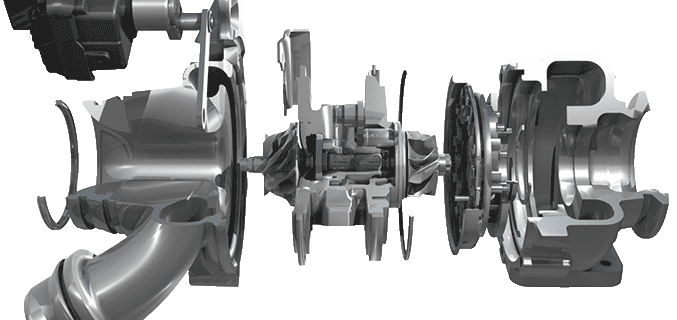


Design engineers create and detail individual component parts and systems based on specifications defined by customers and by related specialist departments like aerodynamics and thermodynamics, material technology and rotor dynamics.
Statistical tolerance calculations are used and requirements for installation and manufacturability are taken into consideration when designing component parts and assemblies using 3D-CAD systems. Prototypes are tested and the knowledge thus obtained is fed back to further optimize the design and guarantee the delivery of optimum charging systems to our end customers.
Every basic and preliminary development project intended to meet future cost and performance objectives on the market is assisted by the design department with regard to later industrial implementation right from the outset.
Meeting and further developing global design standards ensures high quality in the manufacture of our products on three continents.
Our engineers work according to the latest methods available in the field of aerodynamics and thermodynamics.
To optimize the efficiency ratios and flow patterns of components and adapt them to specific customer requirements, we perform three-dimensional and non-steady state simulations of computational fluid dynamics (CFD) for complete compressor and turbine stages.
For compressor and turbine wheels we examine and evaluate the effects created by even the smallest changes in blade shape and size. To meet the needs of the limited space available in engine compartments, casing geometry is fine-tuned individually for every customer application. Our engineers simulate flow to minimize pressure losses and maximize efficiency across the wheels. To control boost pressure, wastegate valves or variable compressor and turbine geometries (e.g., GGS) are used in turbochargers. The flow through them exerts a decisive influence on the efficiency ratio and throughput performance of the entire stage. Computational fluid dynamics are used for optimization. After having developed a customer-specific compressor and turbine geometry, the design is tested under real-life conditions on a hot-gas test bench and finally on an engine.
In rotor dynamics, our engineers assess the influence bearing system, compressor and turbine geometry, as well as shaft geometry exert on the vibration response of the rotor bearing system.
The latest non-linear and coupled calculation methods are available to evaluate the interaction between rotors and bearing systems. To meet high requirements in terms of useful life, acoustics and disturbance-free operation, interactions between bearings and rotors are analyzed initially during development.
The bearing system and the oil circulation inside the bearing casing have a major influence on the mechanical losses which occur during rotor operation. To predict these factors with regard to the overall efficiency of the exhaust-driven turbocharger, simulations are carried out and measurements are made to confirm them.
The combinations of bearing and rotor components found by calculation can be examined to determine their characteristics both under real conditions on a hot-gas test bench or generically on component test benches.
Different materials are specifically selected and applied so as to allow optimal solutions for customers and meet various loading conditions. Less expensive materials are employed selectively for component parts carrying lower loads while superior-grade or even high-performance materials are used for parts subjected to high stresses.
Depending on the engine this can include ferritic or austenitic cast iron or even high alloyed austenitic steel castings, e.g., for the turbine housing.
On the whole, new engine developments lead, e.g., to a higher performance, improved response characteristics or reduced emissions but always create new challenges to be met by turbocharger components and materials. To offer advanced and competitive products in terms of both costs and technology for these future developments, we take new approaches to solve problems and use innovative materials.
Our Heidelberg site has a laboratory with the latest equipment ready to perform detailed materials testing on turbocharger components for preliminary and product development as well as customer validation.
To guarantee the function and safety of our turbochargers during their entire service lives, we apply design concepts, simulation tools and methods according to the latest state-of-the-art and continuously develop them further.
The requirement to be met here is to correctly forecast the complex stresses and strains and the corresponding damage mechanisms which occur under high mechanical loads, i.e., especially at a rotational speed of far more than 200,000 revolutions per minute and at temperatures in a range of between -40°C and far more than 1000°C. Design objectives are defined by relevant customer requirements, load cycles, measured data and internal empirical values and guidelines. The forecasts derived from simulations are compared with the measuring results obtained in basic trials and the design objectives are confirmed by hot-gas engines and vehicle testing on finished products.
Our test centre in Heidelberg puts our products to the test. Modern hot-gas test benches are used to autonomously test and measure exhaust-driven turbochargers as engine components.
The exhaust-gas flow is generated artificially, e.g., by burning natural gas. The test stands are extremely flexible and allow the precise and fully automatic measurement of compressor and turbine maps, as well as the performance of functional trials and endurance testing. The results are discussed in detail with the simulation department in order to allow the fine tuning of calculation models and thus continuously optimize the accuracy of predictions. The interplay of exhaust-driven turbocharger and internal combustion engine is examined directly in the vehicle and on the engine test bed, while simulating engine and vehicle driving modes. We have an integrated prototype workshop with an up-to-date machining centre, enabling us to transform our new developments from CAD models to hardware as quickly as possible and then put them to the test on our test benches. This workshop can supply prototypes and specialist measuring equipment to our customers at short notice. Another segment of the test centre is diagnostics. After the trials, the turbochargers will be completely dismantled into their individual components in the workshops and then measured using the latest equipment in the laboratory. The knowledge obtained in this way is an important factor for component development and for optimizing our charging systems.